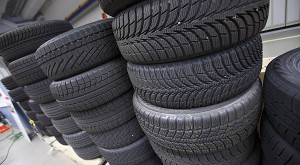Researchers at the Swedish Road and Transport Research Institute (VTI) have studied how grip on wet asphalt under winter conditions deteriorates with the age and wear of different types of winter tyres.
- “We focused in particular on comparing studded and non-studded winter tyres in the testing. We found that the braking and steering performance of studded tyres and Nordic-type tyres on snow-free ground is practically the same for both new and used tyres”, said VTI researcher Mattias Hjort.
The winter tyres were divided into three main categories: studded tyres, non-studded tyres of Nordic type, and non-studded winter tyres of Central European type. A smaller group of summer tyres was tested for the purpose of comparison, and both premium and budget tyres were included in the tests. “When it comes to new tyres, the Central European-type tyres perform roughly 10–13% better than do the other two types of winter tyres. This pertains to both braking and steering”, said Hjort.
In the case of the studded and Nordic-type tyres, there was practically no difference in braking performance between new and worn tyres. Both the Nordic and Central European types of winter tyres clearly exhibited a greater range of braking performance than did the studded tyres, this being true of both new and worn tyres. In contrast, the steering performance did not differ between the tyre types. In principle, the summer tyres perform as well as or better than the Central European-type winter tyres, both when new and when worn.
“However, we must point out that, despite this, it is not appropriate to use summer tyres at low temperatures, as their performance becomes markedly worse than that of winter tyres when ice forms. An earlier VTI study found that the Central European-type winter tyres performed markedly worse than did studded tyres or Nordic-type winter tyres on ice and snow”, said Hjort.
About the study
A total of 84 tyres were tested, i.e., 31 brand new tyres and 53 used ones. The tyres were tested on a wet salted asphalt road at zero degrees Centigrade. All the tyres were tested on VTI’s BV12 mobile tyre test equipment, used to measure the tyres’ braking and steering performance. A subset of the tyres was also tested on a real car. This testing represents the continuation of a study from 2015, which was performed on ice- and snow-covered surfaces (see VTI Report 875).
Report
VTI Report 901, Road grip for worn and new winter tyres
Authors: Mattias Hjort och Olle Eriksson, VTI
Link to full report in Swedish, with summary in English








Follow us: